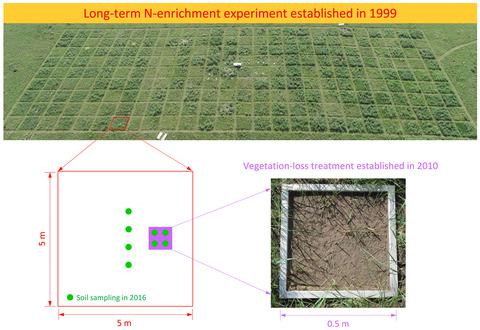当前位置:
X-MOL 学术
›
J. Appl. Ecol.
›
论文详情
Our official English website, www.x-mol.net, welcomes your
feedback! (Note: you will need to create a separate account there.)
Rare soil microbial taxa regulate the negative effects of land degradation drivers on soil organic matter decomposition
Journal of Applied Ecology ( IF 5.0 ) Pub Date : 2021-05-29 , DOI: 10.1111/1365-2664.13935 Ying Wu 1, 2, 3 , Dima Chen 1, 2 , Muhammad Saleem 4 , Bing Wang 1, 2 , Shuijin Hu 5 , Manuel Delgado‐Baquerizo 6 , Yongfei Bai 2, 7
中文翻译:

稀有土壤微生物类群调节土地退化驱动因素对土壤有机质分解的负面影响
更新日期:2021-08-04
Journal of Applied Ecology ( IF 5.0 ) Pub Date : 2021-05-29 , DOI: 10.1111/1365-2664.13935 Ying Wu 1, 2, 3 , Dima Chen 1, 2 , Muhammad Saleem 4 , Bing Wang 1, 2 , Shuijin Hu 5 , Manuel Delgado‐Baquerizo 6 , Yongfei Bai 2, 7
Affiliation

|
- Land degradation drivers, including loss in vegetation and eutrophication, are expected to impact soil biodiversity and functions in drylands world-wide. Soils contain both common and rare microbial taxa that drive multiple soil functions. Yet, little is known about how these microbial taxa influence the impacts of land degradation drivers on ecosystem functions. Obtaining this information is essential to determine whether rare taxa need to be protected, or if protecting only common taxa would be enough to sustain and protect ecosystem functions and services.
- Here, we conducted an experiment to investigate the effects of N-enrichment and vegetation loss (plant removal), which are two major land degradation drivers in semi-arid grasslands, on the diversities of common and rare soil bacterial and fungal taxa and soil function [soil organic matter (SOM) decomposition] in a long-term experiment.
- Six years after N-enrichment and vegetation loss, we found that N-enrichment decreased the alpha diversities of common and rare soil bacteria and rare soil fungi, while vegetation loss only decreased the alpha diversity of rare soil fungi. Both N-enrichment and vegetation loss altered the community composition of common and rare bacteria and fungi, except for the lack of response of common soil fungi to the vegetation loss. Moreover, both structural equation modelling and variation partitioning analyses show that land degradation drivers reduce SOM decomposition, and these were also indirectly associated with changes in the diversity of rare microbial taxa, especially that of bacteria.
- Synthesis and applications. Collectively, this work shows that land degradation can have negative impacts on soil biodiversity and functions, and the rare microbial taxa indirectly regulate the impacts of land degradation on ecosystem functioning. These results indicate that the rare microbial taxa can be used as one of the ecological indicators for identifying land degradation in the semi-arid grasslands. These findings are essential to understand the future impacts of desertification and land degradation on rare microbial taxa–function relationships in global drylands.
中文翻译:

稀有土壤微生物类群调节土地退化驱动因素对土壤有机质分解的负面影响
- 土地退化驱动因素,包括植被减少和富营养化,预计将影响全球旱地的土壤生物多样性和功能。土壤包含驱动多种土壤功能的常见和稀有微生物类群。然而,人们对这些微生物类群如何影响土地退化驱动因素对生态系统功能的影响知之甚少。获取这些信息对于确定是否需要保护稀有类群,或者仅保护常见类群是否足以维持和保护生态系统功能和服务至关重要。
- 在这里,我们进行了一项实验,以研究氮富集和植被损失(植物移除)这两个半干旱草原土地退化的主要驱动因素,对常见和稀有土壤细菌和真菌类群的多样性以及土壤功能的影响【土壤有机质(SOM)分解】长期实验。
- 富氮和植被损失6年后,我们发现富氮降低了常见和稀有土壤细菌和稀有土壤真菌的α多样性,而植被损失仅降低了稀有土壤真菌的α多样性。除了普通土壤真菌对植被损失没有反应外,氮富集和植被损失都改变了常见和稀有细菌和真菌的群落组成。此外,结构方程模型和变异划分分析表明,土地退化驱动因素减少了 SOM 分解,这些也与稀有微生物类群,尤其是细菌多样性的变化间接相关。
- 合成与应用。总的来说,这项工作表明土地退化会对土壤生物多样性和功能产生负面影响,而稀有微生物类群间接调节土地退化对生态系统功能的影响。这些结果表明,稀有微生物类群可以作为识别半干旱草原土地退化的生态指标之一。这些发现对于了解荒漠化和土地退化对全球旱地稀有微生物分类群-功能关系的未来影响至关重要。











































 京公网安备 11010802027423号
京公网安备 11010802027423号